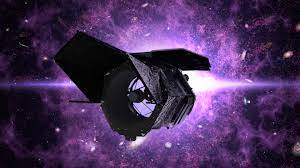About Nancy Grace Roman Space Telescope
- It will provide one of the deepest-ever views into the heart of our Milky Way galaxy.
- Objectives: The mission will monitor hundreds of millions of stars in search of tell-tale flickers that betray the presence of planets, distant stars, small icy objects that haunt the outskirts of our solar system and isolated black holes.
- It will have two instruments
- Wide Field Instrument: It will have a field of view that is 100 times greater than the Hubble infrared instrument, capturing more of the sky with less observing time.
- It will measure light from a billion galaxies over the course of the mission lifetime.
- It will perform a microlensing survey of the inner Milky Way to find ~2,600 exoplanets.
- Coronagraph Instrument: It is a technology demonstration which will perform high contrast imaging and spectroscopy of individual nearby exoplanets.
- Its Galactic Bulge Time-Domain Survey will focus on the Milky Way.
- For this, it will use infrared vision to peer through clouds of dust that can potentially block the view of the crowded central region of our galaxy.
- This telescope plans to capture this by taking an image every 15 minutes around the clock for about two months.
- This process will be repeated six times over Roman’s five-year primary mission, which will total more than a year of observations.
- Scientists will also conduct stellar seismology studies on a million giant stars.
- This will be done by analysing the brightness changes a star undergoes when sound waves are echoed through its gaseous interior.
- This will help them learn about the star’s structure, age and other properties.
Key facts about Milky Way galaxy
- Galaxy type: Barred spiral
- Age: 13.6 billion years (and counting)
- Size: 100,000 light-years across
Q1) What is a coronagraph?
A coronagraph is a specialized optical instrument or device used in astronomy to observe the outermost regions of the solar atmosphere, which is known as the solar corona. It works by blocking out the intense light from the Sun’s disk, allowing the much fainter solar corona to be observed.
Source: NASA readies to launch Roman telescope for humanity’s farthest-ever peek into Milky Way galaxy
Last updated on November, 2025
→ Check out the latest UPSC Syllabus 2026 here.
→ Join Vajiram & Ravi’s Interview Guidance Programme for expert help to crack your final UPSC stage.
→ UPSC Mains Result 2025 is now out.
→ UPSC Notification 2026 is scheduled to be released on January 14, 2026.
→ UPSC Calendar 2026 is released on 15th May, 2025.
→ The UPSC Vacancy 2025 were released 1129, out of which 979 were for UPSC CSE and remaining 150 are for UPSC IFoS.
→ UPSC Prelims 2026 will be conducted on 24th May, 2026 & UPSC Mains 2026 will be conducted on 21st August 2026.
→ The UPSC Selection Process is of 3 stages-Prelims, Mains and Interview.
→ UPSC Result 2024 is released with latest UPSC Marksheet 2024. Check Now!
→ UPSC Prelims Result 2025 is out now for the CSE held on 25 May 2025.
→ UPSC Toppers List 2024 is released now. Shakti Dubey is UPSC AIR 1 2024 Topper.
→ UPSC Prelims Question Paper 2025 and Unofficial Prelims Answer Key 2025 are available now.
→ UPSC Mains Question Paper 2025 is out for Essay, GS 1, 2, 3 & GS 4.
→ UPSC Mains Indian Language Question Paper 2025 is now out.
→ UPSC Mains Optional Question Paper 2025 is now out.
→ Also check Best IAS Coaching in Delhi

















